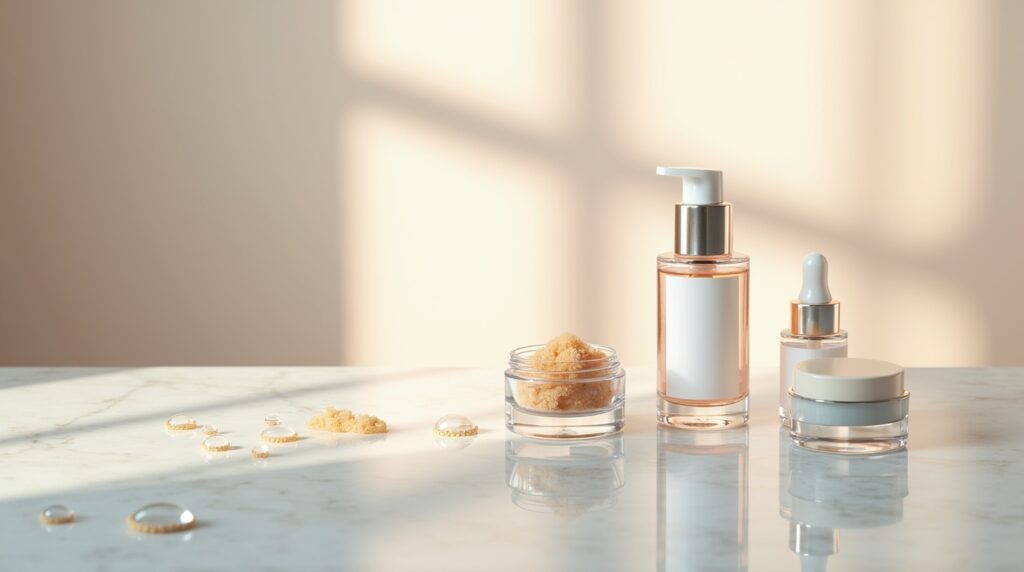Skinification integrates skincare into beauty routines, emphasizing products that enhance skin health while providing cosmetic benefits, driving trends towards multifunctional formulations and natural ingredients.
Skinification is changing how we view beauty and self-care. Have you noticed how skincare routines are becoming a part of our daily lives? Let’s dive into this fascinating trend!
Table of Contents
ToggleUnderstanding the concept of skinification and its impact on beauty trends?
Skinification refers to the trend of treating skincare as an essential part of beauty routines, much like makeup. This shift emphasizes healthy skin over traditional makeup applications, promoting a more natural look. In today’s world, where self-care is prioritized, the desire for glowing skin is higher than ever.
How Skinification Influences Beauty Products
With the rise of skinification, brands are now creating products that cater to both skincare and makeup needs. Many foundations include SPF and hydrating properties, while serums are formulated with pigments for a subtle glow. This intersection allows consumers to enjoy the benefits of skincare while enhancing their appearance.
The Role of Social Media
Social media platforms have played a crucial role in the spread of skinification. Influencers and beauty gurus share their skincare routines, showcasing how natural skin looks radiant and healthy. This visibility encourages followers to shift their focus from heavy makeup to nurturing their skin.
Benefits of Prioritizing Skin Health
Focusing on skin health can lead to improved overall appearance and confidence. Regular hydration, for example, can enhance your skin’s radiance, while consistent use of products rich in vitamins can help maintain elasticity. Prioritizing skincare promotes self-love and encourages individuals to embrace their natural beauty.
The intersection of skincare and makeup: a glimpse into the skinification movement?

The intersection of skincare and makeup is an evolving area in the beauty industry where both realms combine to enhance natural beauty. Many brands now produce products that serve dual purposes, offering skincare benefits while providing cosmetic coverage. For example, foundation products often include moisturizing ingredients and sun protection, making them beneficial for the skin.
Why Skinification Matters
Skinification represents a shift in consumer preferences, with more people prioritizing skin health over heavy makeup. This movement encourages individuals to invest in their skincare routine, leading to healthier, glowing skin without the need for excessive cosmetics.
Popular Products in the Skinification Trend
Common products found in this intersection include tinted moisturizers, BB creams, and serums with added pigments. These allow users to achieve a polished look while nourishing the skin at the same time. They often contain hydrating and anti-aging ingredients that help improve skin texture and resilience.
The Influence of Beauty Influencers
Beauty influencers are key in promoting the skinification movement through tutorials and product recommendations. They demonstrate how to achieve radiant skin and share tips on combining skincare and makeup effectively. This visibility drives consumer demand for innovative products that blend these categories.
Key factors driving the skinification of beauty?
Several key factors are driving the skinification of beauty, fundamentally changing how consumers approach their skincare and makeup routines. One major factor is the increasing awareness of skincare’s role in enhancing overall health and beauty. People are becoming more educated about skin health and seeking products that nourish rather than mask imperfections.
The Rise of Minimalism
Minimalism has gained traction in beauty, with more consumers looking for multi-functional products. This shift emphasizes fewer products that serve multiple purposes, leading to the creation of items like serum foundations that combine skincare and makeup.
Influence of Social Media
Social media platforms are pivotal in promoting skinification. Influencers showcase their skincare routines, inspiring followers to adopt similar practices. This direct engagement creates a community that values natural beauty and healthy skin.
Demand for Transparency
Consumers today prefer brands that are transparent about their ingredients. They seek products that contain skin-friendly ingredients such as hyaluronic acid and vitamins, which promise better results and reflect a more holistic approach to beauty.
Self-Care Trends
The growing emphasis on self-care has also contributed to skinification. People treat their skincare routines as part of their wellness rituals, fostering a culture where taking care of the skin is seen as a form of self-love.
How does skinification affect product formulation and development?

The trend of skinification is fundamentally changing how beauty products are formulated and developed. Brands are now focusing on ingredients that offer skincare benefits along with cosmetic performance. This shift means that makeup products are increasingly incorporating nourishing ingredients like hyaluronic acid, vitamins, and antioxidants.
Formulation Innovations
To meet the demands of consumers seeking healthier options, many companies invest in research to create innovative formulations. This includes developing products that provide hydration and improve skin texture while also enhancing the complexion.
Consumer Preferences
As consumers prioritize skincare, brands must adapt their product lines. Items like BB creams and tinted moisturizers have become popular because they offer both coverage and skincare benefits. This dual-purpose appeal aligns with current beauty trends where less is more.
Focus on Transparency
Consumers are now more aware of what goes into their products. There is a growing demand for brands to be transparent about their ingredient lists. This focus on transparency can influence formulation choices, as brands strive to use ingredients that are both effective and safe.
Creating a beauty regimen in the era of skinification?
Creating a beauty regimen in the era of skinification means focusing on skin health as the foundation of beauty. This approach encourages selecting products that enhance natural beauty while providing nourishment. Begin with a solid cleansing routine to make sure your skin is clean and ready to absorb beneficial ingredients.
Step 1: Cleanser
Choose a gentle cleanser that suits your skin type. Cleansing helps remove impurities and prepares your skin for further treatments. Look for options with natural ingredients that hydrate while cleaning.
Step 2: Serum
Incorporate a serum that targets your specific skin concerns. Serums with ingredients like vitamin C for brightening or hyaluronic acid for hydration can significantly improve your skin’s texture and glow.
Step 3: Moisturizer
After applying serum, use a moisturizer to lock in hydration. A lightweight gel or cream that suits your skin type will keep your skin smooth and hydrated throughout the day.
Step 4: Sunscreen
Never skip sunscreen, even on cloudy days. This is crucial for protecting your skin from harmful UV rays. Look for a broad-spectrum formula that offers at least SPF 30.
Step 5: Makeup
When applying makeup, opt for skin-friendly products that also provide treatment benefits. Tinted moisturizers or mineral foundations can offer coverage while allowing your skin to breathe. Aim for a natural finish that enhances your complexion rather than masking it.
Skinification-inspired products in the market and their unique properties?

Many skinification-inspired products have emerged in the market, blending skincare and makeup qualities. These products cater to the growing demand for beauty solutions that enhance skin health while providing aesthetic benefits. One popular category is hydrating makeup, which includes foundations that contain moisturizing ingredients.
Hydrating Foundations
Hydrating foundations often include hyaluronic acid or glycerin, which work to keep skin moist throughout the day. These ingredients help reduce the appearance of fine lines, giving a smoother look while providing coverage.
Serum-Infused Makeup
Another trend is serum-infused products, such as BB creams and tinted moisturizers. These formulations combine skincare benefits with light coverage, making them ideal for daily wear. They often contain antioxidants and vitamins that nourish the skin.
Mineral Makeup
Mineral makeup has gained popularity for its skin-friendly properties. Often free from harsh chemicals, these products can soothe sensitive skin while providing coverage. They typically contain natural SPF, adding an extra layer of protection.
Highly Pigmented Skincare
Some brands are releasing highly pigmented skincare products that not only treat the skin but also give a burst of color. These products often include tinted serums that provide a natural glow while improving skin texture.
Potential drawbacks and criticism of the skinification movement?
While the skinification movement has gained popularity, it also faces potential drawbacks and criticism. One concern is that it may promote an unrealistic standard of beauty. The focus on achieving perfect skin can lead individuals to feel inadequate if their skin does not meet these ideals.
Overemphasis on Perfection
The skinification trend can create pressure to invest heavily in skincare solutions, which may not always yield the desired results. This obsession with flawless skin can cause anxiety, especially if individuals spend significant time and money on products.
Neglect of Personal Needs
An emphasis on trendy products might lead consumers to neglect their unique skin needs. Not every product marketed for skinification will be suitable for all skin types. It’s crucial to prioritize personalized skincare rather than blindly following trends.
Greenwashing Concerns
Some brands may exploit the skinification trend by promoting products as natural or beneficial when they contain harmful ingredients. This can mislead consumers and damage the credibility of genuinely beneficial products.
Commercialization of Self-Care
Finally, the commercialization of self-care associated with skinification can detract from its authentic meaning. Beauty rituals should promote well-being and self-acceptance, rather than becoming just another marketing strategy.
How can brands successfully incorporate skinification into their strategy?

To successfully incorporate skinification into their strategy, brands need to focus on several key areas. First, it is important to understand customer needs and preferences. Conducting surveys and gathering feedback can help brands know what consumers are looking for in skincare and makeup products.
1. Focus on Ingredients
Brands should prioritize high-quality, skin-friendly ingredients in their formulations. Incorporating natural and effective components, like hyaluronic acid and antioxidants, can align products with the skinification trend and attract health-conscious consumers.
2. Education and Transparency
Educating consumers about the benefits of skincare ingredients is vital. Brands can provide clear information on product formulations and how they improve skin health. Transparency fosters trust and encourages customers to choose these products.
3. Multi-Functional Products
Developing multi-functional products that serve both skincare and makeup needs is essential. For example, creating tinted moisturizers or serum-infused foundations can appeal to consumers who want practicality without sacrificing quality.
4. Seamless Marketing
Marketing campaigns should highlight how these skinification products enhance natural beauty. Utilize social media and influencer collaborations to demonstrate real-world benefits, showing how these products fit into everyday beauty routines.
5. Customer Engagement
Engaging directly with customers through social media platforms can provide valuable insights and create a community around the brand. Encouraging user-generated content through reviews and before-and-after photos can enhance authenticity.
Future predictions: what’s next for the skinification trend?
The future of the skinification trend looks promising as it continues to evolve within the beauty industry. One significant prediction is the further blending of skincare with makeup products. This means consumers will see more products designed to provide both aesthetic appeal and skincare benefits, making beauty routines more efficient.
1. Increased Focus on Personalization
As technology advances, brands will likely focus on personalized beauty solutions. Customizable products tailored to individual skin types and concerns could become a standard. This shift caters to the growing demand for products that address unique needs.
2. More Natural Ingredients
Consumers are becoming more conscious of the ingredients in their products. The demand for clean and natural ingredients will likely rise, leading brands to formulate products that are effective yet safe for all skin types. Transparency in ingredient sourcing will also be important.
3. Emerging Technologies
Advancements in technology, such as artificial intelligence and augmented reality, will play a role in skinification. These technologies will enable brands to create innovative products and virtual try-ons, enhancing the shopping experience.
4. Emphasis on Sustainability
Sustainable beauty will continue to gain traction. Brands will need to focus on eco-friendly packaging and ethical sourcing of ingredients. The conscious consumer seeks brands that align with their values regarding the environment.
5. Community Engagement
Future marketing strategies will likely engage communities more. Brands may use social media platforms to create interactive campaigns that encourage customer feedback and foster relationships, creating loyal communities around their products.









